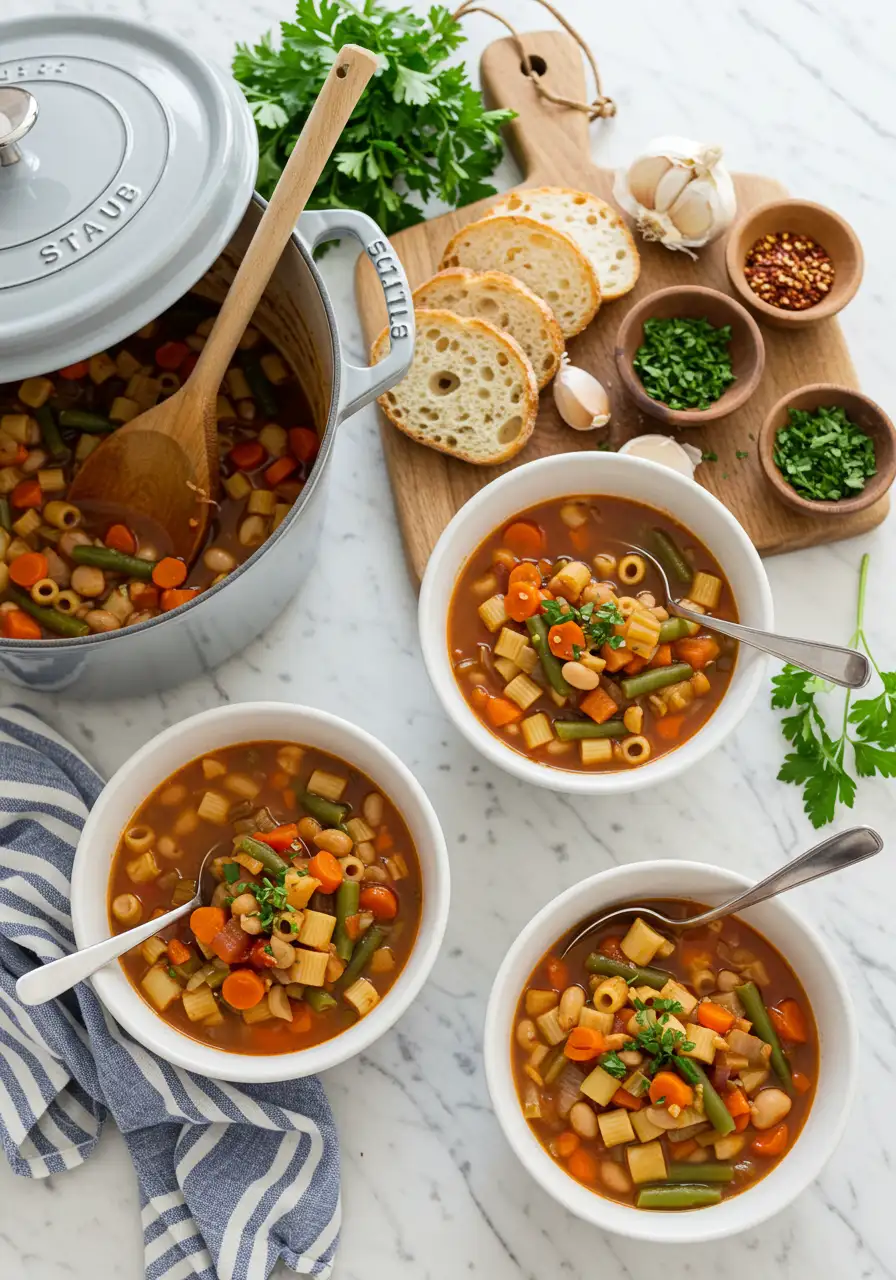Are you ever hit with that craving for a truly comforting, deeply satisfying meal, something packed with flavor but without the fuss of hours spent over a hot stove? That’s exactly where this Easy Vegan Minestrone Soup shines. It masterfully delivers all the heartwarming, rustic charm you expect from the beloved Italian classic – think a vibrant medley of colorful vegetables, protein-rich beans, and those delightful little pasta shells – yet it comes together with surprising speed and simplicity. Forget lengthy simmering; this recipe streamlines the process, proving that you can achieve rich, complex flavor without dedicating your entire afternoon to cooking.”
More than just a starter, this minestrone is robust enough to stand as a complete, nourishing meal on its own, perfect for busy weeknights or relaxed, cozy weekends. It’s designed to fill you up and leave you feeling genuinely satisfied and energized by its plant-powered goodness. And here’s a little secret: it’s one of those magical dishes that tastes even better the next day as the flavors meld and deepen. So whether you follow a strict vegan lifestyle or are simply looking for delicious ways to incorporate more vegetables into your routine, prepare to welcome this hearty, easy minestrone into your regular recipe rotation – it’s bound to become a dependable favorite.
Table of Contents
Key Benefits
Nutrient-Dense and Pure: This Vegan Minestrone Soup is packed with fresh vegetables, beans, and whole grains, making it a great source of vitamins, minerals, and fiber—all while being absolutely Sattvic in nature.
Comforting and Light: The rich broth and soft vegetables translate to a dish that is both comforting and light, perfect for warming up on a chilly day without feeling weighed down.
Versatile and Easy: One‑pot simplicity and adaptable ingredients make this Vegan Minestrone Soup easy to adapt based on what you have on hand while still maintaining a rich flavor profile.
Ingredients for Vegan Minestrone Soup
For the Soup Base:
- Water: 6 cups (or combine water and light vegetable broth to give it extra flavor)
- Fresh Tomatoes: 2 large, diced (or one 14.5‑oz can of diced tomatoes with juices, unsalted)
- Tomato Paste: 1 tablespoon (optional, for more color and a richer flavor)
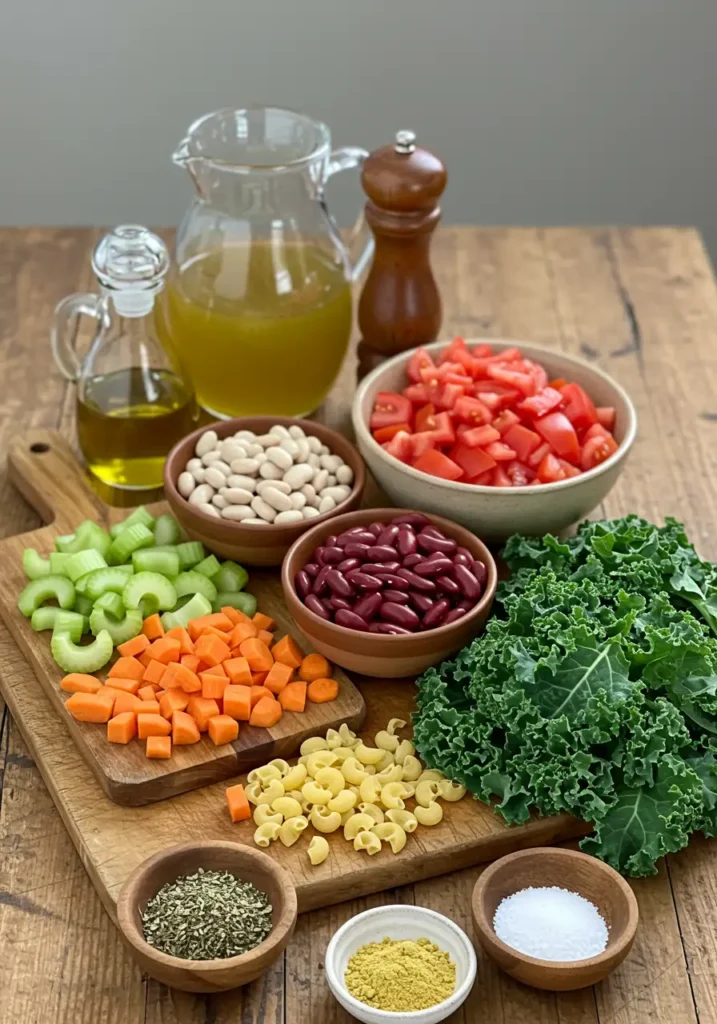
Vegetables:
- Carrots: 2 medium, peeled and diced into ½‑inch pieces
- Celery: 2 stalks, diced (using inner stalks gives a milder flavor)
- Sweet Potato: 1 small, peeled and cubed into ½‑inch pieces
- Green Beans: 1 cup, trimmed and cut into 1‑inch pieces
- Kale: 2 large leaves, de‑stemmed and chopped (or use baby spinach)
- Zucchini: 1 medium, sliced into half‑moons
Protein and Pasta:
- Kidney Beans: 1 can (15 oz), rinsed and drained (or use cannellini/white beans)
- Small Pasta: ¾ cup (elbow macaroni, small shells, or ditalini; gluten‑free if needed)
Flavor Enhancers (Sattvic Adaptation):
- Asafoetida (Hing): ⅛ teaspoon (Optional, for a savory taste rather than garlic/onion. If feasible, use pure hing.)
- Ginger: 1‑inch piece, finely grated (substitutes garlic pungency)
- Turmeric Powder: ½ teaspoon (warmth and deep color)
- Mild Italian Seasoning: 1 tablespoon (a blend of dried basil, oregano, and thyme works)
- Salt: To taste (start with ½ teaspoon and adjust accordingly)
- Freshly Ground Black Pepper: To taste
Optional Garnish:
- Vegan Parmesan Cheese: A light sprinkle for extra flavor
- Fresh Parsley: Chopped, about 2 teaspoons for a burst of freshness
- Note: This recipe adheres to Sattvic guidelines by omitting onions and garlic. If desired, add 1 teaspoon of lemon juice at the end for brightness.
How To Make Vegan Minestrone Soup
Step 1: Prepare Your Vegetables
- Wash and Chop: Wash all fresh vegetables. Peel and chop the carrots, celery, and sweet potato into uniform ½‑inch pieces. Trim the ends of the green beans and slice them into segments about 1 inch long. De‑stem and chop the kale (or substitute baby spinach) and slice the zucchini into half‑moons.
- Dice Tomatoes: If using fresh tomatoes, chop them uniformly. (For canned tomatoes, simply open and combine in the juice.)
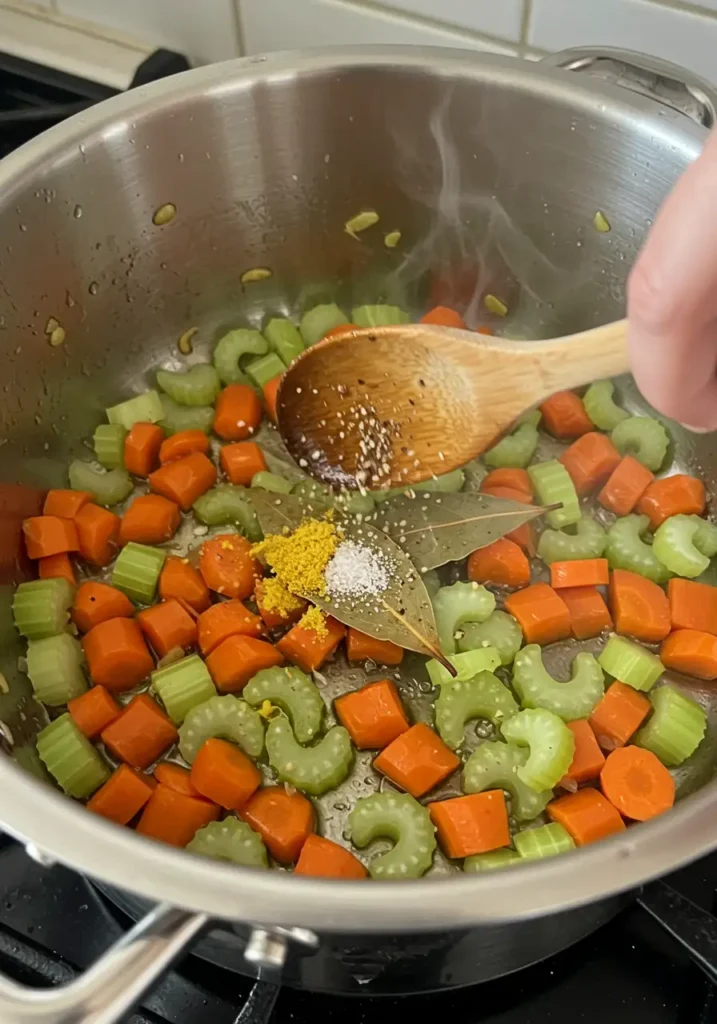
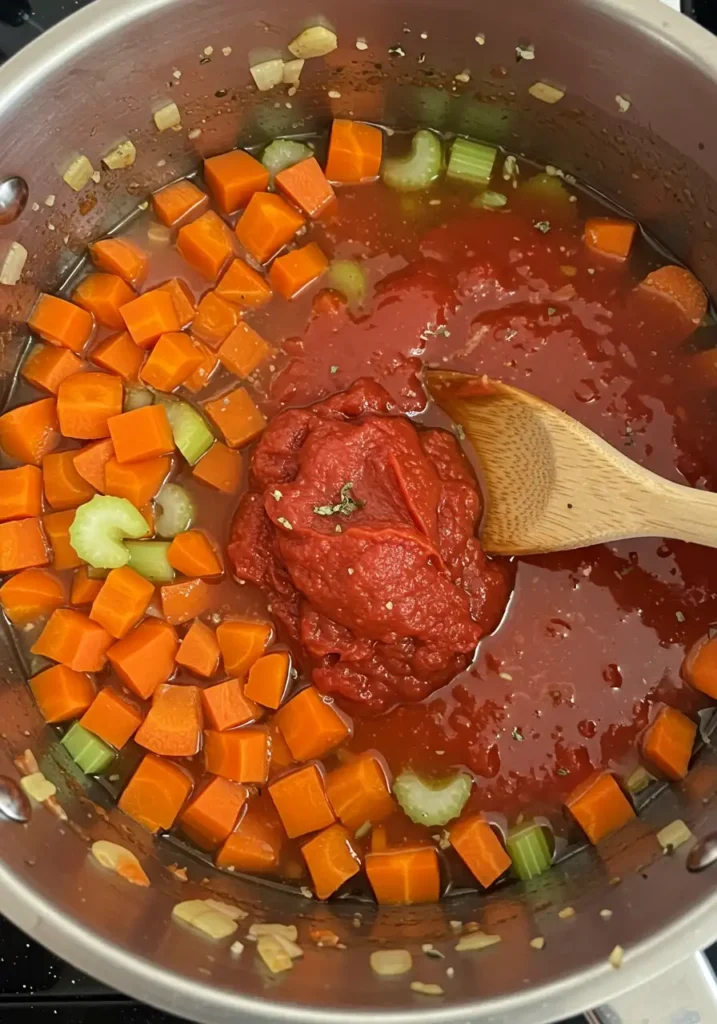
Step 2: Build the Base
- Heat the Pot: Put 6 cups of water (or a mixture of water and light vegetable broth) in a large, heavy‑bottomed pot and bring to a low simmer over medium heat.
- Add Tomatoes: Add the diced tomatoes and tomato paste (if using). Allow these to cook for 5 minutes or so to begin getting the flavors incorporated.
Step 3: Add Vegetables and Spices
- Add the Veggies: Add the sweet potato, celery, and carrots to the boiling water. Stir and let them cook for about 10 minutes until they begin to soften.
- Add More Veggies: Add the zucchini, green beans, and kale. Stir gently to combine.
- Spice It Up: Include the grated ginger, turmeric powder, and mild Italian seasoning.Season with salt and a generous amount of freshly ground black pepper, according to your preference. Simmer for another 5–7 minutes until the vegetables are tender but retain a bit of crunch.
Step 4: Add Beans and Pasta
- Beans: Gently stir in the rinsed kidney beans (or beans of your choice) into the pot.
- Pasta: Add small pasta. Reduce the heat to low and let the Vegan Minestrone Soup simmer uncovered for about 8–10 minutes, stirring occasionally, until the pasta is al dente. Be careful not to overcook it, as pasta absorbs more broth.
Step 5: Final Adjustments
- Season and Taste: Finally, taste the soup and season if necessary. Add a touch of tanginess by incorporating 1 teaspoon of lemon juice.
- Garnish: Remove the pot from heat and ladle the Vegan Minestrone Soup into bowls. Garnish a spoonful of vegan parmesan cheese on top of each serving and chopped fresh parsley.
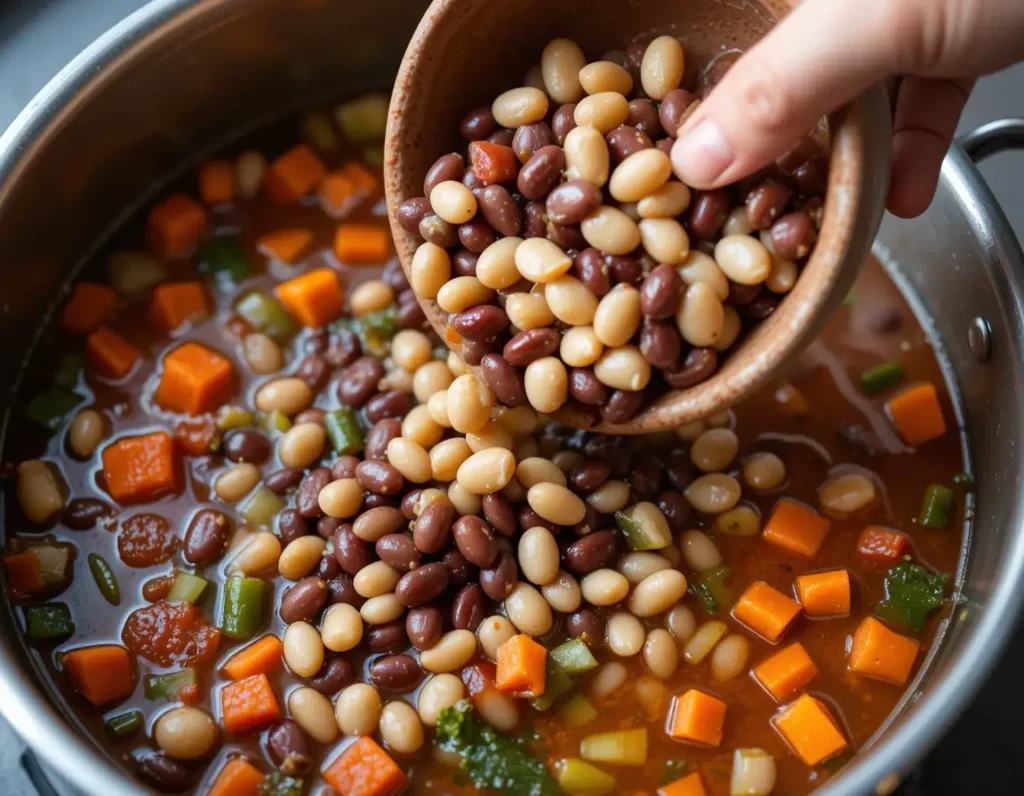
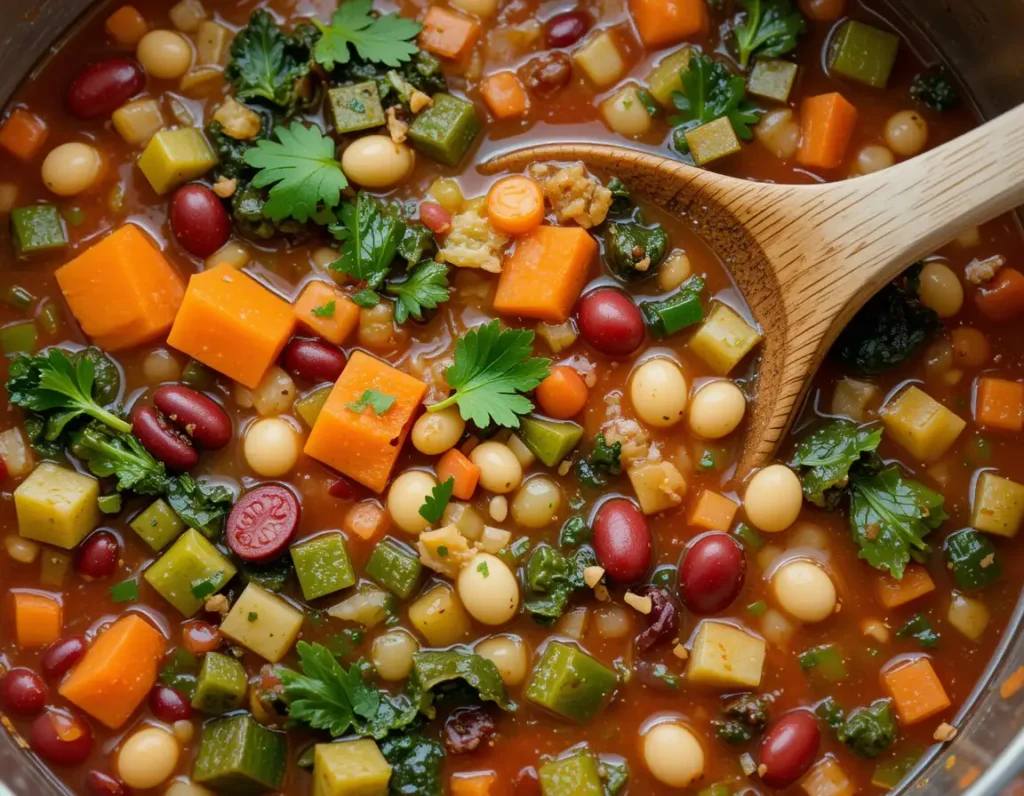
Pro Tips and Variations
Gluten-Free:
- Use gluten-free pasta or swap the pasta for quinoa or rice.
Sattvic Adjustments:
- Traditional minestrone recipes require garlic and onions, but in this Sattvic version of Vegan Minestrone Soup, we substitute them with fresh ginger to maintain a mild flavor profile.
- Allow the vegetable and tomato mix to simmer a bit more before adding beans and pasta for a more developed flavor.
Pasta Options:
- To prepare this gluten-free, substitute regular pasta with gluten-free alternatives like quinoa pasta or rice pasta.
- To keep a heartier broth, you might cook your pasta separately and add it when you’re ready to serve.
Extra Veggies:
- Customize the vegetable mix based on what’s available seasonally. You might add bell peppers, butternut squash, or other leafy greens if you prefer.
- Leafy greens like Swiss chard or collard greens are a nice substitute for kale. Add these toward the end of the cooking process.
Flavor Boosters:
- A bay leaf may be added during simmering (remember to take it out before serving).
- For an additional kick, add a small pinch of mild red pepper flakes—but sparingly to preserve the Sattvic quality.
Batch Cooking and Storage:
- This recipe is suitable for batch cooking. Let the Vegan Minestrone Soup cool, then pour it into airtight containers. It will keep 3–4 days in the fridge or 3 months in the freezer.
- When reheating, you will probably need to add a splash of water or broth since the pasta continues to absorb liquid.
Serving Suggestions
With Bread:
- Serve alongside a hot bowl of Vegan Minestrone Soup and a serving of toasted sourdough or crusty whole-grain bread. For added flavor, rub the bread with a fresh clove of ginger or drizzle a little olive oil over the top.
Salad Pairing:
- A simple green salad tossed in a light lemon-tahini dressing is perfect. The crunchy freshness of the salad makes a pleasant contrast to the hot, comforting Vegan Minestrone Soup.
Light Garnish:
- Garnish the soup with some fresh sprouts (such as mung bean sprouts) or a sprinkle of nutritional yeast for extra nutrition and a cheesy flavor.
Meal Prepping:
- Vegan Minestrone Soup is ideal for meal prep. Enjoy a large bowl and store extra servings in single portions, so you have a quick and healthy meal throughout the week.
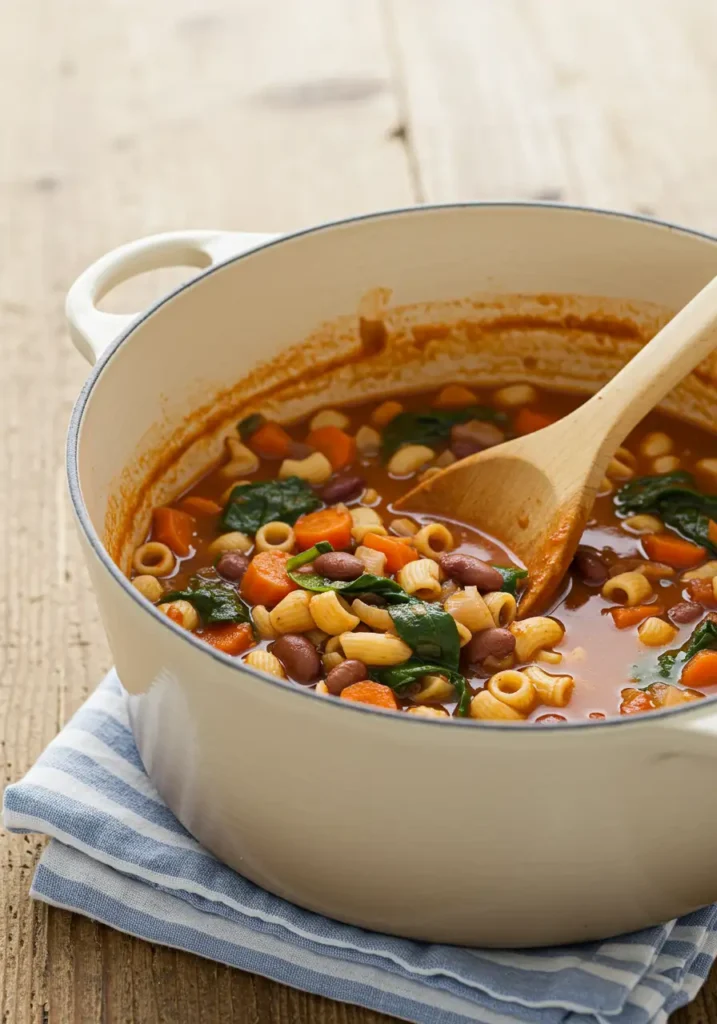
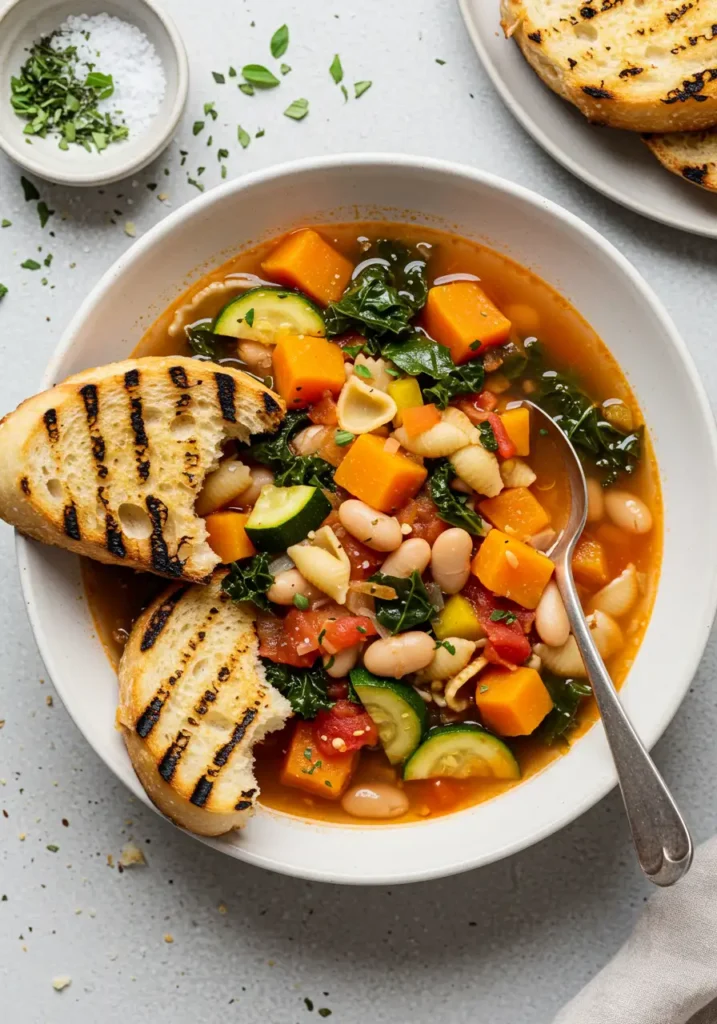
Final Thoughts
This vibrant, Sattvic Vegan Minestrone Soup is a testament to the strength of quality, straightforward ingredients blended into a recipe as healthy as it is delicious. By prioritizing fresh, season vegetables and low-and-slow-cooked spices like ginger and turmeric, this recipe shuns the fat of other forms while providing a crisp, easy taste that honestly does heal the body and spirit.
This vegan minestrone soup dishes up fresh, healthy goodness in every spoonful. Its warm mix of fresh season vegetables, beans, and pasta is a healthful meal that fits beautifully into a Sattvic diet. By using pure, plant-based ingredients and a clear, wonderful tasting broth, you have a dish that’s cleansing and soothing.
This recipe encourages the principle of mindful eating, where each component is chosen for its natural purity and healing quality. The blending of vegetables and legumes without making the dish heavy and drowsy is a judiciously harmonious one that enhances digestion and health.
Have this light, vibrant, effortless soup as a healthy lunch or dinner and remember that healthy, Sattvic food can be simplicity itself yet very, very delicious.
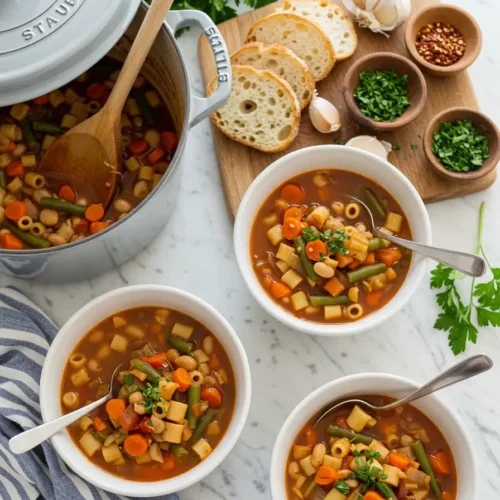
Vegan Minestrone Soup
Ingredients
For the Soup Base:
- Water: 6 cups or combine water and light vegetable broth to give it extra flavor
- Fresh Tomatoes: 2 large diced (or one 14.5‑oz can of diced tomatoes with juices, unsalted)
- Tomato Paste: 1 tablespoon optional, for more color and a richer flavor
Vegetables:
- Carrots: 2 medium peeled and diced into ½‑inch pieces
- Celery: 2 stalks diced (using inner stalks gives a milder flavor)
- Sweet Potato: 1 small peeled and cubed into ½‑inch pieces
- Green Beans: 1 cup trimmed and cut into 1‑inch pieces
- Kale: 2 large leaves de‑stemmed and chopped (or use baby spinach)
- Zucchini: 1 medium sliced into half‑moons
Protein and Pasta:
- Kidney Beans: 1 can 15 oz, rinsed and drained (or use cannellini/white beans)
- Small Pasta: ¾ cup elbow macaroni, small shells, or ditalini; gluten‑free if needed
- Flavor Enhancers Sattvic Adaptation:
- Asafoetida Hing: ⅛ teaspoon (Optional, for a savory taste rather than garlic/onion. If feasible, use pure hing.)
- Ginger: 1‑inch piece finely grated (substitutes garlic pungency)
- Turmeric Powder: ½ teaspoon warmth and deep color
- Mild Italian Seasoning: 1 tablespoon a blend of dried basil, oregano, and thyme works
- Salt: To taste start with ½ teaspoon and adjust accordingly
- Freshly Ground Black Pepper: To taste
Optional Garnish:
- Vegan Parmesan Cheese: A light sprinkle for extra flavor
- Fresh Parsley: Chopped about 2 teaspoons for a burst of freshness
- Note: This recipe adheres to Sattvic guidelines by omitting onions and garlic. If desired add 1 teaspoon of lemon juice at the end for brightness.
Instructions
Step 1: Prepare Your Vegetables
- Wash and Chop: Wash all fresh vegetables. Peel and chop the carrots, celery, and sweet potato into uniform ½‑inch pieces. Trim the ends of the green beans and slice them into segments about 1 inch long. De‑stem and chop the kale (or substitute baby spinach) and slice the zucchini into half‑moons.
- Dice Tomatoes: If using fresh tomatoes, chop them uniformly. (For canned tomatoes, simply open and combine in the juice.)
Step 2: Build the Base
- Heat the Pot: Put 6 cups of water (or a mixture of water and light vegetable broth) in a large, heavy‑bottomed pot and bring to a low simmer over medium heat.
- Add Tomatoes: Add the diced tomatoes and tomato paste (if using). Allow these to cook for 5 minutes or so to begin getting the flavors incorporated.
Step 3: Add Vegetables and Spices
- Add the Veggies: Add the sweet potato, celery, and carrots to the boiling water. Stir and let them cook for about 10 minutes until they begin to soften.
- Add More Veggies: Add the zucchini, green beans, and kale. Stir gently to combine.
- Spice It Up: Include the grated ginger, turmeric powder, and mild Italian seasoning.Season with salt and a generous amount of freshly ground black pepper, according to your preference. Simmer for another 5–7 minutes until the vegetables are tender but retain a bit of crunch.
Step 4: Add Beans and Pasta
- Beans: Gently stir in the rinsed kidney beans (or beans of your choice) into the pot.
- Pasta: Add small pasta. Reduce the heat to low and let the Vegan Minestrone Soup simmer uncovered for about 8–10 minutes, stirring occasionally, until the pasta is al dente. Be careful not to overcook it, as pasta absorbs more broth.
Step 5: Final Adjustments
- Season and Taste: Finally, taste the soup and season if necessary. Add a touch of tanginess by incorporating 1 teaspoon of lemon juice.
- Garnish: Remove the pot from heat and ladle the Vegan Minestrone Soup into bowls. Garnish a spoonful of vegan parmesan cheese on top of each serving and chopped fresh parsley.
Notes
- Calories: ~350 kcal
- Protein: ~15 g
- Fat: ~10 g
- Saturated Fat: ~1.5 g
- Carbohydrates: ~50 g
- Fiber: ~12 g
- Sugar: ~8 g
- Sodium: Varies significantly based on vegetable broth and added salt.
- Also provides: Good source of Vitamin A, Vitamin C, Iron, Potassium.
FAQs
Is minestrone vegan?
Traditional minestrone soup is not typically vegan. It typically contains ingredients like meat-based broth (beef or chicken), pancetta, or dairy parmesan cheese. But it’s quite simple to create a delicious vegan minestrone soup like this recipe! We use vegetable broth, omit the meat, and provide optional vegan parmesan cheese. When ordering out or using a packaged product, always check ingredients.
What does minestrone soup taste like?
Minestrone soup has a strong, savory taste with the dominance of the taste of cooked vegetables and herbs in a tasty broth. You will get the sweetness of carrot, the earthiness of the beans (kidney beans, cannellini beans), the mild tang of diced tomatoes, and the fresh flavors of celery and green beans. The pasta also contributes a cozy texture. This Sattvic version is especially clean and bright in vegetable taste, avoiding as it does the pungent flavor of onion and garlic, so the natural goodness of the veggies can shine through.
How healthy is minestrone soup?
Minestrone soup, and particularly a vegan adaptation such as this one, is very healthy. It’s full of fiber, vitamins, and minerals due to all the vegetables and beans. It’s a healthy recipe that’s fairly low in fat (if you’re careful with the oil used in sautéing) and high in vegetarian nutrients. The beans also offer protein, so it’s a balanced and satisfying hearty soup.
What soups can vegans eat?
Vegans can indulge in a huge variety of delicious soups! Most soup recipes are either naturally vegan or easily adapted. Some examples are lentil soup, tomato soup (by using vegetable broth and plant milk/cream if creamy), black bean soup, butternut squash soup, mushroom soup (by using vegetable broth), potato leek soup (by using plant milk), and of course, this incredible vegan minestrone soup. Look for vegan soup recipes specifically, or adapt traditional ones by swapping meat broth for vegetable broth, omitting meat/dairy, and using plant-based creams if needed. There are many great vegan soup options.
Why is it called minestrone soup?
“Minestrone” comes from the Italian word minestra, meaning “soup,” and the augmentative suffix -one, which means “big.” So, minestrone literally translates as “big soup.” The title defines the nature of the soup – it’s typically made with a large number and variety of ingredients, generally seasonal vegetables, beans, and typically pasta or rice, so it is a thick vegetable soup, hearty.
Are all pastas vegan?
Most dried pasta found in supermarkets is vegan. It is typically made from just durum wheat (semolina) and water. However, always check the ingredients. Some pasta, particularly fresh pasta (usually in the chilled food aisle), may contain eggs. Egg noodles clearly do contain eggs. So, while most pasta is suitable for vegans, it is worth checking the label quickly to make sure. Gluten-free pasta is mostly vegan but, as always, best to check ingredients.
What’s the difference between this vegan minestrone soup and a regular non-vegan one ?
Base Flavor: The most significant difference in this Sattvic vegan minestrone soup is the absence of onion and garlic. Traditional minestrone almost always uses these for its flavor base. Our Sattvic version uses sautéed carrot and celery, good-quality vegetable broth, tomato paste, herbs, and optional asafoetida (hing) for umami depth. This results in a cleaner, fresher overall taste in which the individual vegetable flavors are more distinct.
Ingredients: While both contain plenty of vegetables, beans, and typically pasta, a typical minestrone might include non-Sattvic items like mushrooms or very pungent spices, pancetta, meat broth, or dairy parmesan. Our recipe is strictly vegan and Sattvic (purity, balance, not using overstimulating ingredients).
Focus: This recipe is characterized by fresh, easily digestible food promoting a sense of balance, in accordance with Sattvic dietary principles. A typical minestrone focuses essentially on bold flavor and using whatever vegetables are available, without these specific dietary considerations.

